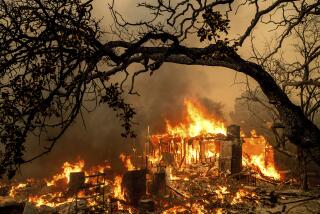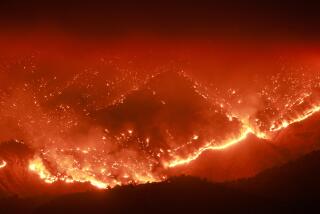Firefighters battling seven blazes in Washington state
- Share via
Reporting from Seattle — More than 1,000 firefighters battled seven blazes in Washington on Friday, as a heat wave blasted through the state, threatening to aggravate conditions in one of the most active fire regions in the country.
Only three outbuildings had been damaged by the fires in the north-central part of the state by Friday afternoon, authorities said, and no injuries had been reported.
However, more than 100 homes were under orders to evacuate, and the residents of an additional 150 or so were told to be ready to leave at a moment’s notice. Roads have been closed, several campgrounds have been shuttered and smoke is visible from miles away.
The fires, which are largely burning in steep wilderness areas, were all caused by human activity, said Robin DeMario, a spokeswoman for the Northwest Coordination Center, a multi-agency firefighting effort. “But we don’t know what the exact cause is,” she added.
The Mills Canyon fire, which has burned more than 18,000 acres since it began on Tuesday, was only 19% contained Friday, DeMario said. Not far from the central Washington town of Entiat, the blaze is the largest and fiercest in the state, responsible for more than 200 evacuation alerts or orders and being fought by more than 600 personnel.
“It’s in steep, inaccessible terrain,” DeMario said, “burning in grass, brush, timber and fuel left over from previous fires over the years. There is a lot of dead material on the forest floor.”
Around 50 homes have been warned that evacuations could be necessary because of the Lake Spokane fire. Torching more than 1,000 acres since Wednesday afternoon, the blaze, just 23 miles northwest of Spokane in eastern Washington, is the second-worst in the state and is only 30% contained.
On Thursday, the state Department of Natural Resources closed the Spokane Lake Recreation Area to allow fire crews to battle the blazes. Two other campgrounds were closed because of the 25 Mile Creek fire near the town of Chelan.
Bob Tobin, a National Weather Service meteorologist based in Spokane, said the fire season has arrived a couple of weeks ahead of schedule, fueled by unseasonably warm weather.
Temperatures in eastern Washington at this time of year usually hover in the low to mid-80s, Tobin said. However, “we’ve got a very strong ridge of high pressure over us. We are very warm and very dry. … We’re running 10 to 12 degrees above normal.”
Although “no big wind events” are expected in the next five days or so, he said, a series of thunderstorms is expected over the weekend, bringing more lightning than rain to the region and “more potential for initiating wildfires.”
Seattle, too, is bracing for a nearly week-long heat wave, with temperatures in the 90s forecast through Wednesday.
“Some record highs may be broken during this stretch,” AccuWeather.com meteorologist Andy Mussoline said on the forecaster’s website. “The normal high is 75 F.”
But not all of the country will be sweltering through record high temperatures this July. Just travel a couple of thousand miles east, and you’ll find residents of Chicago bracing for what is being compared to January’s “polar vortex.”
That’s what some people are calling the unseasonably cold temperatures expected to come to the northern and eastern U.S. next week, as a patch of cold air flows from northern Canada to the Great Lakes area and slips eastward toward the coast.
The temperature in some areas will slide as low as 15 to 20 degrees below normal, and some states are likely to see cold rain and thunderstorms as the air mass moves in, according to the National Weather Service.
The upper Midwest could see some of the coldest weather, with highs in the low to mid-60s, and parts of the Chicago area could even see lows overnight dip into the 40s, forecasters say.
Residents as far south as Nashville could feel a 10-degree drop. And some areas could flirt with record low temperatures for July, said Andy Foster, meteorologist for the National Weather Service’s Central Region.
Times staff writer Christine Mai-Duc contributed to this report.
Follow @marialagnaga for national news
More to Read
Sign up for Essential California
The most important California stories and recommendations in your inbox every morning.
You may occasionally receive promotional content from the Los Angeles Times.














